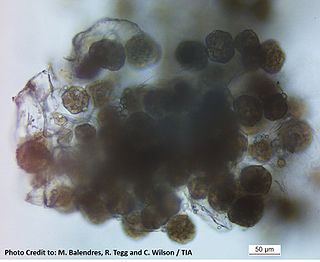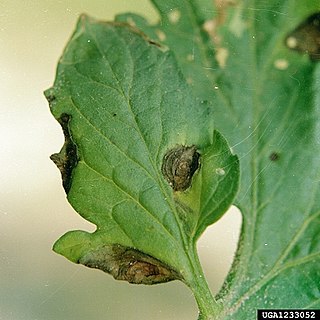
The peanut, also known as the groundnut, goober (US), pindar (US) or monkey nut (UK), is a legume crop grown mainly for its edible seeds. It is widely grown in the tropics and subtropics, important to both small and large commercial producers. It is classified as both a grain legume and, due to its high oil content, an oil crop. World annual production of shelled peanuts was 44 million tonnes in 2016, led by China with 38% of the world total. Atypically among legume crop plants, peanut pods develop underground (geocarpy) rather than above ground. With this characteristic in mind, the botanist Carl Linnaeus gave peanuts the specific epithet hypogaea, which means "under the earth".

Venturia inaequalis is an ascomycete fungus that causes the apple scab disease.

Phomopsis cane and leaf spot occurs wherever grapes are grown. Phomopsis cane and leaf spot is more severe in grape-growing regions characterized by a humid temperate climate through the growing season. Crop losses up to 30% have been reported to be caused by Phomopsis cane and leaf spot.

Powdery scab is a disease of potato tubers. It is caused by the cercozoan Spongospora subterranea f. sp. subterranea and is widespread in potato growing countries. Symptoms of powdery scab include small lesions in the early stages of the disease, progressing to raised pustules containing a powdery mass. These can eventually rupture within the tuber periderm. The powdery pustules contain resting spores that release anisokont zoospores to infect the root hairs of potatoes or tomatoes. Powdery scab is a cosmetic defect on tubers, which can result in the rejection of these potatoes. Potatoes which have been infected can be peeled to remove the infected skin and the remaining inside of the potato can be cooked and eaten.
Alternaria triticina is a fungal plant pathogen that causes leaf blight on wheat. A. triticina is responsible for the largest leaf blight issue in wheat and also causes disease in other major cereal grain crops. It was first identified in India in 1962 and still causes significant yield loss to wheat crops on the Indian subcontinent. The disease is caused by a fungal pathogen and causes necrotic leaf lesions and in severe cases shriveling of the leaves.
Cercospora arachidicola is a fungal ascomycete plant pathogen that causes early leaf spot of peanut. Peanuts originated in South America and are cultivated globally in warm, temperate and tropical regions.
Mycosphaerella angulata is a fungal plant pathogen infecting muscadine grapes. This pathogen causes the common disease angular leaf spot. Mycosphaerella angulate is an ascomycete in the fungi kingdom.
Mycosphaerella berkeleyi is a fungal plant pathogen. It is the causal agent of the peanut foliar disease Late Leaf Spot.

Alternaria solani is a fungal pathogen that produces a disease in tomato and potato plants called early blight. The pathogen produces distinctive "bullseye" patterned leaf spots and can also cause stem lesions and fruit rot on tomato and tuber blight on potato. Despite the name "early," foliar symptoms usually occur on older leaves. If uncontrolled, early blight can cause significant yield reductions. Primary methods of controlling this disease include preventing long periods of wetness on leaf surfaces and applying fungicides. Early blight can also be caused by Alternaria tomatophila, which is more virulent on stems and leaves of tomato plants than Alternaria solani.
Elsinoë mangiferae, common name "mango scab", is also known Denticularia mangiferae or Sphaceloma mangiferae (anamorph). It is an ascomycete plant pathogen native to tropical regions and specific for survival on only one host, the mango. Originally described in 1943 from Florida and Cuba specimens, this pathogen has since spread worldwide and is becoming a pathogen of great concern for the mango industries in Australia and India. The species was first described formally in 1946.
Sphaceloma perseae is a plant-pathogenic fungus in the division Ascomycota. It infects the avocado plant, a tree native to Central America and Mexico. Currently there are three cultivars of avocados in large-scale agricultural production: Guatemalan, Mexican, and West Indian. The pathogen is currently limited to the P. Americana species but is able to infect all three cultivars. The resulting disease is known as avocado scab for the symptoms which are present on the fruit of the avocado tree. It is believed that the disease developed in Florida in the early twentieth century and is related to citrus scab, Elsinoe fawcetti. Since then, S.perseae has spread to many regions worldwide that support cultivation of the avocado tree. This pathogen threatens the global avocado market, including both importers and exporters of the crop. Countries which import avocados, including the United States, have experienced a rising demand over the past decade which is projected to continue for years to come. An understanding of avocado scab characteristics and feasible prevention methods is essential to maintenance of cultures and economies influenced by the avocado fruit.

Colletotrichum coccodes is a plant pathogen, which causes anthracnose on tomato and black dot disease of potato. Fungi survive on crop debris and disease emergence is favored by warm temperatures and wet weather.

Gibberella fujikuroi is a fungal plant pathogen. It causes bakanae disease in rice seedlings.
Septoria lycopersici is a fungal pathogen that is most commonly found infecting tomatoes. It causes one of the most destructive diseases of tomatoes and attacks tomatoes during any stage of development.

Diaporthe phaseolorum var. sojae is a plant pathogen infecting soybean and peanut.

Septoria malagutii is a fungal plant pathogen infecting potatoes. The casual fungal pathogen is a deuteromycete and therefore has no true sexual stage. As a result, Septoria produces pycnidia, an asexual flask shaped fruiting body, on the leaves of potato and other tuber-bearing spp. causing small black to brown necrotic lesions ranging in size from 1-5mm. The necrotic lesions can fuse together forming large necrotic areas susceptible to leaf drop, early senescence, dieback, and dwarfing. Septoria malagutii has been found only in the Andean countries of Bolivia, Ecuador, Peru, and Venezuela at altitudes of near 3000 meters. Consequently, the fungi grows and disperses best under relatively low temperatures with high humidities, with optimal growth occurring at 20 °C (68 °F). The disease has caused devastation on potato yields in South America and in areas where this disease is common, potato yields have been seen to drop by 60%.
Peanut stunt virus (PSV) is a plant pathogenic virus in the family Bromoviridae. It is a member of the genus Cucumovirus. The members of this genus are positive-stranded RNA viruses with a multipartite genome. The virus particles have an isometric or spherical shape.
This article summarizes different crops, what common fungal problems they have, and how fungicide should be used in order to mitigate damage and crop loss. This page also covers how specific fungal infections affect crops present in the United States.
Peach scab, also known as peach freckles, is a disease of stone fruits caused by the fungi Cladosporium carpophilum. The disease is most prevalent in wet and warm areas especially southern part of the U.S. as the fungi require rain and wind for dispersal. The fungus causes scabbing, lesions, and defoliating on twig, fruit, and leaf resulting in downgrade of peach quality or loss of fruits due to rotting in severe cases.
Alternaria black spot of canola or grey leaf spot is an ascomycete fungal disease caused by a group of pathogens including: Alternaria brassicae, A. alternata and A. raphani. This pathogen is characterized by dark, sunken lesions of various size on all parts of the plant, including the leaves, stem, and pods. Its primary economic host is canola. In its early stages it only affects the plants slightly by reducing photosynthesis, however as the plant matures it can cause damage to the seeds and more, reducing oil yield as well.








